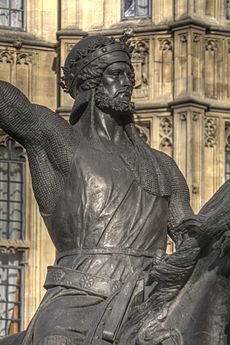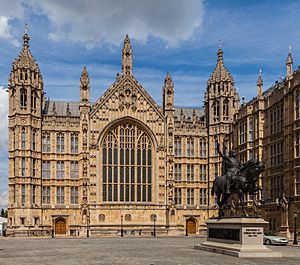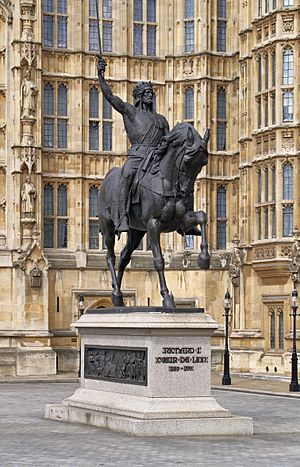Richard Coeur de Lion (statue) facts for kids
Quick facts for kids Richard Coeur de Lion |
|
|---|---|
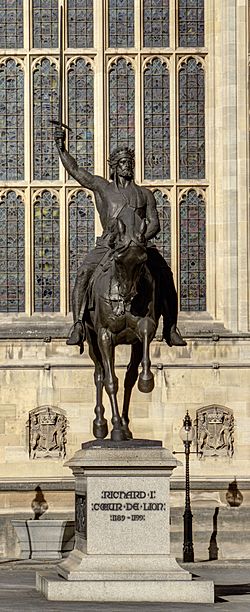
The sculpture in 2015
|
|
| Artist | Carlo Marochetti |
| Year |
|
| Type | Equestrian statue |
| Dimensions | 9 m (30 ft) |
| Location | London, SW1 United Kingdom |
The Richard Coeur de Lion statue is a famous bronze sculpture in London. It shows King Richard I, also known as Richard the Lionheart, riding a horse. Richard was an English king who ruled from 1189 to 1199.
This impressive statue stands on a granite base in Old Palace Yard. This is a special area outside the Palace of Westminster, where the UK Parliament meets. The Italian artist Baron Carlo Marochetti created the statue. His art was very popular with kings, queens, and noble families across Europe.
The first version of the statue was made from clay. It was shown at The Great Exhibition in 1851. This was a huge event where countries showed off their inventions and art. People really liked the statue. Two years later, Queen Victoria and Prince Albert helped raise money to make the statue out of bronze.
Even after the bronze statue was finished in 1856, it took several years to find a home for it. There were many arguments about where to put it. Finally, everyone agreed to place it in Old Palace Yard, which was the artist Marochetti's favourite spot. The statue was put in place in October 1860. Later, in 1867, bronze pictures called bas-reliefs were added to the sides of its base.
The statue had some problems early on. The horse's tail even fell off the day after it was first shown! Years later, people found it had holes and wasn't properly attached to its base. The statue also nearly got destroyed during World War II. A German bomb exploded nearby, bending Richard's sword and damaging the horse's tail and the base. In 2009, experts worked to clean and fix the statue, making sure it stays safe for many more years.
Contents
About the Statue
The Richard Coeur de Lion statue was made by Baron Carlo Marochetti. It is located in Old Palace Yard, right outside the Palace of Westminster in London. This is across from Westminster Abbey. The statue, including its base, is about 9 metres (30 feet) tall.
The statue shows King Richard I on his horse, ready for battle. He wears a helmet with a crown and a special shirt made of chainmail armour. He also has a surcoat over his armour. Richard is holding his sword high in the air. The horse looks like it's about to charge into a fight. Marochetti said he was inspired by Richard I, but he didn't try to make the statue look exactly like a 12th-century knight.
The statue stands on a granite base. This base was also designed by Marochetti. On the sides of the base, there are bronze pictures called bas-reliefs. These pictures were added in 1866–67. One shows Crusaders fighting at the Battle of Ascalon. The other shows Richard on his deathbed, forgiving the archer who shot him in 1199.
You can't get very close to the statue because the area around it is used for parking. But you can see the picture of Richard on his deathbed from the street. Marochetti said these bronze pictures were inspired by the famous doors at the Florence Baptistry in Italy. The front of the base has the words "RICHARD I CŒUR DE LION / 1189–1199" written on it.
Most of the art around the Houses of Parliament is by British artists. This is because there's a rule to choose British art for the building. So, Marochetti's statue is one of the few artworks by a non-British artist chosen for this important place.
Statue's Journey and History
Making the Statue and Its First Display
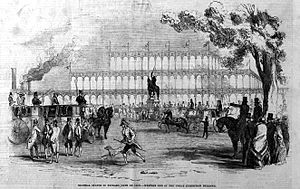
Carlo Marochetti was born in Italy. He became a nobleman in the Kingdom of Sardinia. He lived and worked in France for many years, creating important statues for the French royal family. He became famous for his statues of people on horseback. For example, he made a statue of the Duke of Wellington in Glasgow in 1840.
By the 1840s, Marochetti's popularity in Europe was fading. When the French monarchy was overthrown in 1848, he moved to London. He hoped to find new supporters among the rich and powerful in Britain.
Some British art critics didn't like Marochetti's work. The magazine Punch even made fun of his name. But he had strong support from Queen Victoria and Prince Albert. Queen Victoria was impressed by his polite manners when they met in 1849. Soon after, he became involved in Prince Albert's plans for The Great Exhibition of 1851.
Many countries wanted to show sculptures of historical heroes at the exhibition. Marochetti knew that a Belgian artist, Eugene Simonis, planned to show a statue of Godfrey of Bouillon, a leader of the First Crusade. Marochetti probably wanted to compete with Simonis when he designed his Richard I statue.
Marochetti worked with other artists and even singers to create the clay model of the statue. This clay model was placed outside the western entrance of the Crystal Palace in Hyde Park. But it wasn't put together very well. The horse's tail fell off shortly after the exhibition opened on May 1, 1851!
The tail was fixed, and the statue became very popular. The art critic John Ruskin said it would teach the public more about art than anything in centuries. Prince Albert even showed it to King Leopold of Belgium. The Art Journal later called it a "vigorous and spirited example of sculpture."
Casting the Statue and Finding a Home
After the exhibition, a military officer named Charles Richard Fox suggested making a bronze copy of the statue. He thought it could be a memorial to the Great Exhibition. In 1853, a campaign started to raise money for the bronze statue. Many important people supported it, including dukes, lords, and even future Prime Minister Benjamin Disraeli. The Times newspaper also strongly supported the project.
The Royal Family showed their support too. Queen Victoria gave £200, and Prince Albert gave £100.
However, deciding where to put the statue was a big problem from the start. Fox's idea of putting it in Hyde Park was set aside. Some people questioned why a statue of a "valiant crusader" was chosen to remember an exhibition about "peace." The Lord Mayor of London, Thomas Challis, said the statue showed "savage ferocity of war" instead of the "cordial friendship of nations" that the exhibition celebrated.
Others criticised the statue for not being realistic. The Times noted that Richard's chainmail shirt was so tight it showed his muscles, which wasn't how real chainmail looked.
Despite the criticism, £5,000 was raised from private donations to make the bronze version. Parliament then agreed to pay £1,650 for the base and another £1,500 for the two bronze pictures (bas-reliefs) on its sides. In 1854, a plaster version of the statue was placed outside Westminster Hall. But Charles Barry, the architect of the Palace of Westminster, didn't want it there. The Art Journal also said the statue was just a novelty and showed an "unworthy subject." The plaster statue was removed by May 1854.
In 1856, Marochetti finally had the statue cast in bronze at his workshop. Now that the statue was finished and given to the nation, finding a permanent home for it became even more urgent. Other places were considered, like outside Buckingham Palace or even on top of Marble Arch. Prince Albert suggested putting it outside Westminster Abbey.
Punch magazine made fun of the long search for a location. They called Richard I "the Wandering Statue of London." They asked if anyone would find a place for this "fugitive king."
Marochetti suggested putting it in Old Palace Yard, outside the south window of Westminster Hall. The Fine Arts Commission for the Palace of Westminster agreed. But Sir Charles Barry, the architect, still didn't like the idea. He thought Old Palace Yard was too small and uneven for such a grand artwork. Marochetti, however, liked the unevenness of the spot. The argument continued until 1859. Finally, Lord John Manners, the Commissioner of Works, agreed to put the statue in Marochetti's preferred spot. By this time, Sir Charles Barry was very ill and passed away in 1860, so he couldn't object anymore.
Installation and Later History
Parliament paid for the statue's base, which was made from granite from Cornwall. But there were delays in getting it there. Finally, on October 26, 1860, the statue was placed on its base and shown to the public. At first, it was plain, but a bronze shield was added to the front of the base soon after.
The Times newspaper said that putting up the statue had "removed a great reproach from London." They claimed Marochetti's Richard I was one of the few great equestrian statues in Europe. However, not everyone agreed. The critic Francis Turner Palgrave called it a "low-class work." It was said that London's taxi drivers especially liked the statue and would tie their horses nearby.
Marochetti also wanted to add more bronze pictures (bas-reliefs) to the sides of the base. He planned four scenes: Richard's coronation, the Battle of Ascalon, Richard as a prisoner, and Richard on his deathbed. He asked for £2,500 for all four. But Parliament only agreed to give him £1,500 for two scenes: Ascalon and Richard's death.
Marochetti accepted the job and made plaster models of the pictures. The bronze picture of the deathbed scene was added to the base in August 1866. The Taking of Ascalon was added in March 1867. The Art Journal criticised the deathbed scene, saying it was too stretched out.
Marochetti also tried to get another giant horse statue, this time of Edward, the Black Prince, placed in Old Palace Yard. He imagined the two statues facing each other. But this idea never happened. Prince Albert's death in 1861 meant Marochetti lost his most important supporter. Marochetti himself died in 1867. Queen Victoria bought a smaller version of the Black Prince statue after Marochetti's death. It is now part of the Royal Collection.
The statue has needed repairs several times. A few months after it was put up, people noticed it swayed in strong winds. In 1908–09, frost damaged one of the horse's front legs. Workers found 60–80 leaks inside the statue, causing more damage when water froze. They also discovered the statue wasn't properly attached to its base. It was just resting on it! Repairs were done to fix these issues.
The statue was damaged during World War II. On September 26, 1940, a large German bomb hit Old Palace Yard during the Blitz. The bomb exploded very close to the statue. It reportedly lifted the statue off the ground. The top part of Richard's sword was bent, and the horse's tail got several holes from bomb fragments.
The High Commissioner for Canada, Vincent Massey, thought the sword should be left bent. He said it showed how "democracy will bend but not break under attack." However, the sword was replaced in 1947, and other repairs were done. You can still see some damage to the base today. The statue was given special "Grade II listed" status in February 1970, meaning it's an important historical building.
In the summer of 2009, experts spent three weeks working on the statue. They cleaned off old dirt and black wax. They also restored the bronze surface to its original colour and added a clear wax to protect it from pollution and weather. The bronze pictures on the base and the base itself were also cleaned and treated.
See also
 In Spanish: Estatua de Ricardo Corazón de León para niños
In Spanish: Estatua de Ricardo Corazón de León para niños


